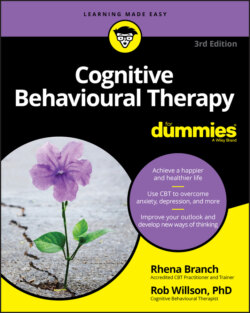Читать книгу Cognitive Behavioural Therapy For Dummies - Rob Willson - Страница 16
Making the Thought–Feeling Link
ОглавлениеLike many people, you may assume that if something happens to you, the event makes you feel a certain way. For example, if your partner treats you inconsiderately, you may conclude that she makes you angry. You may further deduce that her inconsiderate behaviour makes you behave in a particular manner, such as sulking or refusing to speak to her for hours (possibly even days; people can sulk for a very long time!). We illustrate this common (but incorrect) causal relationship with the following formula. In this equation, the A stands for a real or actual event – such as being rejected or losing your job. It also stands for an activating event that may or may not have happened. It could be a prediction about the future, such as ‘I’m going to get the sack’, or a memory of a past rejection, such as ‘Hilary will dump me just like Judith did ten years ago’. C stands for consequence, which means the way you feel and behave in response to an actual or activating event.
A (actual or activating event) = C (emotional and behavioural consequence)
CBT encourages you to understand that your thinking or beliefs lie between the event and your ultimate feelings and actions. Your thoughts, your beliefs and the meanings that you give to an event produce your emotional and behavioural responses.
So in CBT terms, your partner does not make you angry and sulky. Rather, your partner behaves inconsiderately, and you assign a meaning to her behaviour such as ‘She’s doing this deliberately to upset me, and she absolutely should not do this!’, thus making yourself angry and sulky. In the next formula, B stands for your beliefs about the event and the meanings you give to it.
A (actual or activating event) + B (beliefs and meanings about the event) = C (emotional and behavioural consequence)
This is the formula or equation that CBT uses to make sense of your emotional problems.
